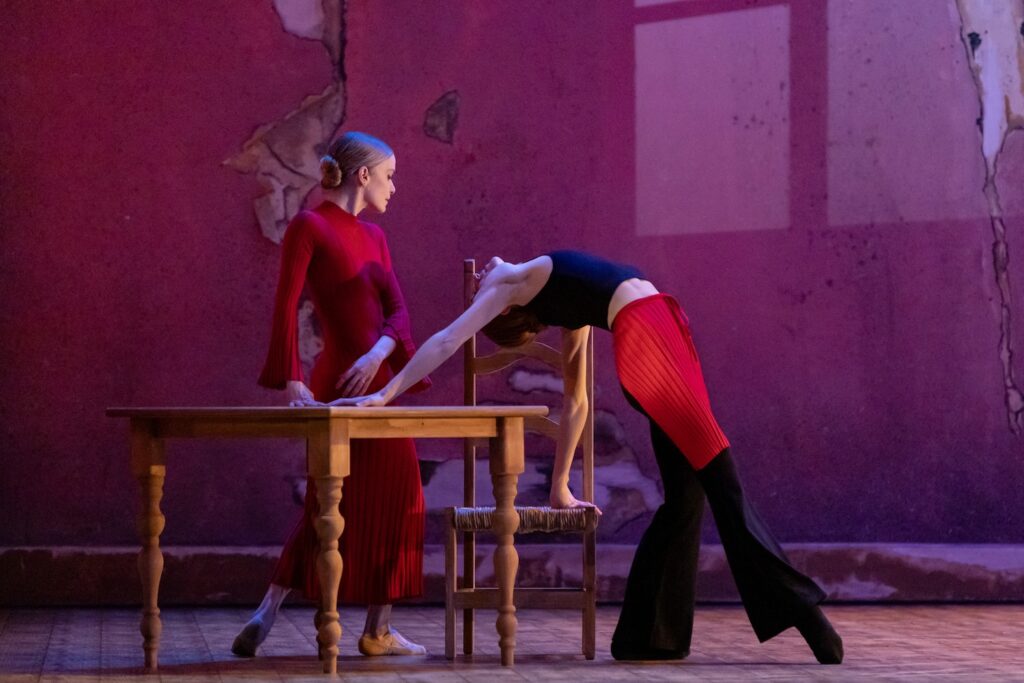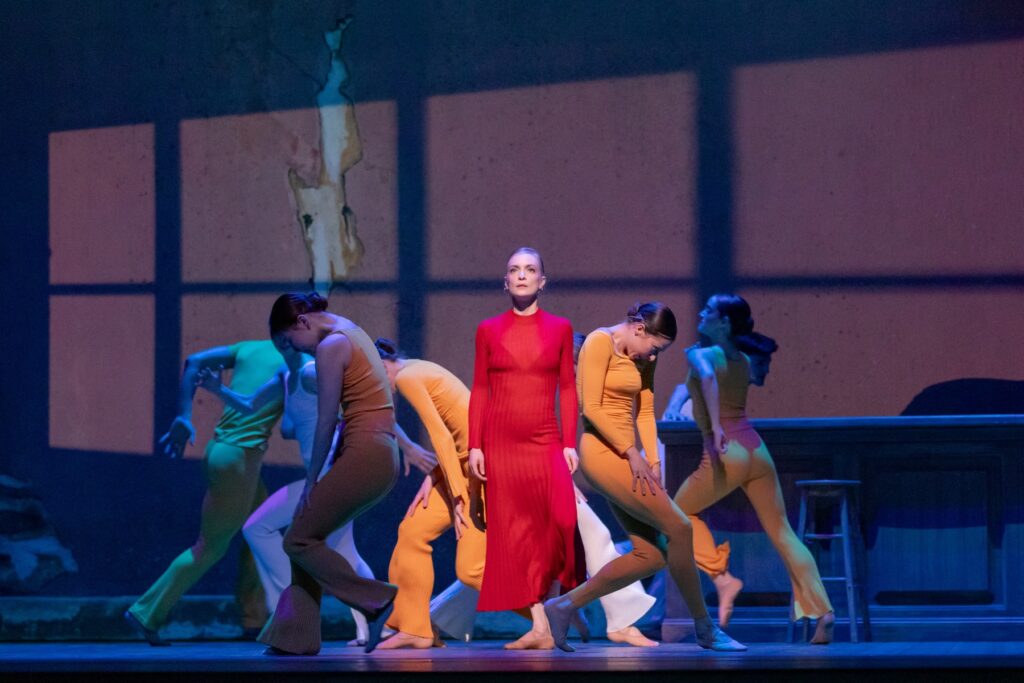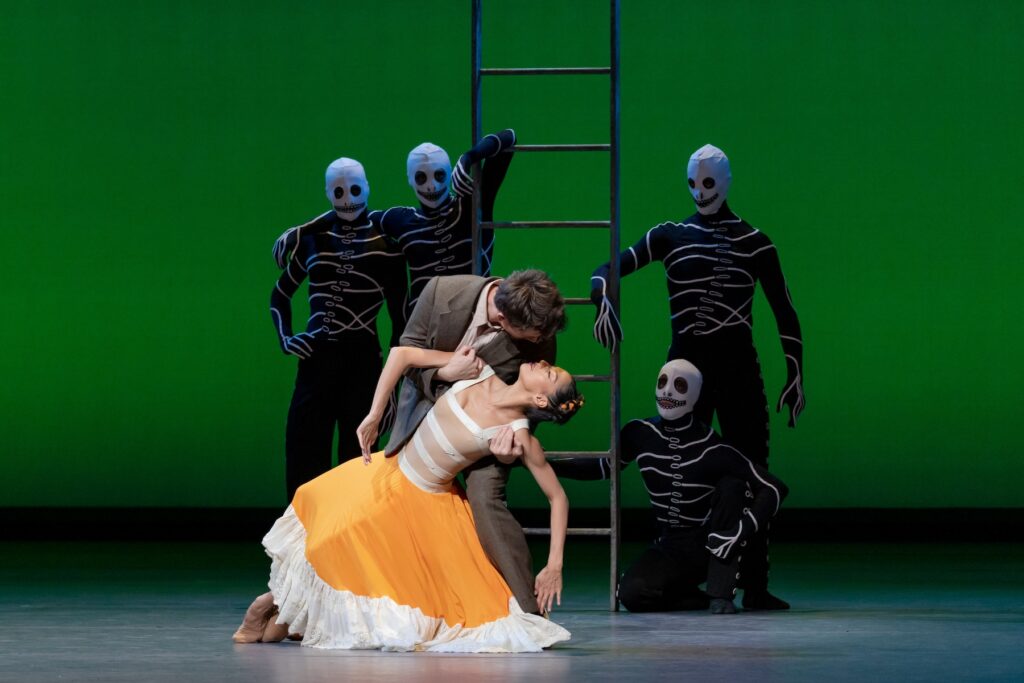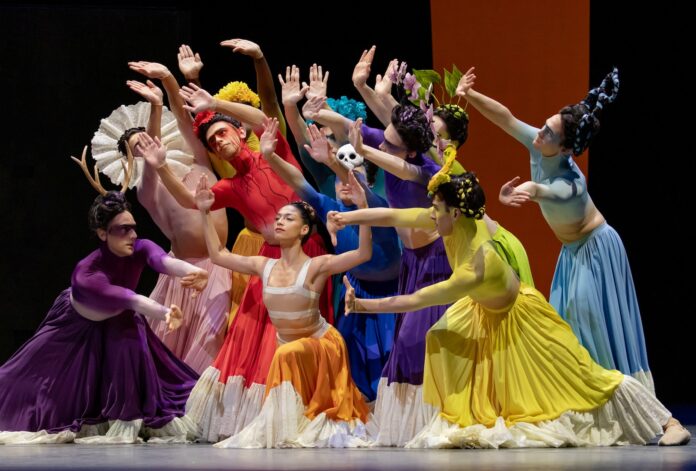As we continue to look for a bigger picture to define the nascent tenure of SF Ballet artistic director Tamara Rojo, we can at least say this: she’s adding some much-needed color to the company, sometimes literally and figuratively. Both are on display in the lobby, which has been adorned for their latest show with papel picados and paper flowers as far as they eye can see, the latter even lining the mezzanine balcony in the theatre. The pre-show curtain is a gorgeous tapestry of Latin American imagery, by Oakland’s own Maria Guzmán Capron, that deserves to be seen in person.
Most notably, the audience for Dos Mujeres (through April 14 at the War Memorial Opera House, SF) boasted a refreshingly more prominent Latine presence on the day I went. The Canadian-born and Spanish-raised Rojo seems to have gone all out for Dos Mujeres in a way one would expect the Ballet to reserve for its annual Nutcracker production. That can’t be a coincidence.

The title refers to the two pieces in the show, both by Latina choreographers and both centering two well-known women, one fictional and one very real. The first is the world premiere of Arielle Smith’s Carmen. Yes, this piece was very, very loosely based Bizet’s “Habanera”-spawning opera and the French novella that inspired it. The action has been moved to Cuba, where we find the eponymous object of affection (played with exaggerated vamping by Sasha de Sola) torn between loyalty to her father, restaurant-owner Gilberto (Wei Wang), and her dedication to her husband, José (Joseph Walsh). If that weren’t enough, the arrival of a new chef, Escamillo (Jennifer Stahl), further complicates matters, as she and Carmen appear to see eye-to-eye, in more ways than one. Not to spoil anything, but the ending is considerably different than that of Bizet’s classic.
This was my introduction to Smith’s work; I watched this piece thinking it was “very telenovela”. Every gesture is presented in the most melodramatic fashion, exaggerated to grand heights so as to leave no mystery about these characters’ desires. De Sola practically becomes an electric blur of red over the course of the performance. I dare say it was the dance equivalent to scenery-chewing (and Ricardo Hernández’s set is wonderfully detailed, even when it later transitions into “nothingness”), but that’s not a bad thing. Carmen has always been melodramatic. People often forget that even Shakespeare’s plays were made for the plebes, only to later be appropriated by the aristocracy. In that context, Smith’s take on the story is almost like a means of snatching the story away from the clutched pearls and dropped monocles that so often define the story’s audience. Besides, a classic like Carmen was long overdue for an overtly queer redux.

An intermission is followed by the SF premiere of Annabelle Lopez Ochoa’s Broken Wings, the second Frida Kahlo-Diego Rivera fantasy to grace the Opera House stage within a year. Ochoa’s ballet is more a proper Frida biography (as performed by Isabella Devivo) with Diego Rivera (John-Paul Simeons) as, appropriately, the most recurring supporting character in her life story. Said story is told from the point-of-view of a semi-Greek chorus of Mexican skeletons who become Frida’s tormentors and empathetic travel companions through all the major events in her life: her precocious childhood; the auto accident; the tempestuous, affair-filled marriage to Diego. All are presented as an hypnotic fever dream based on the late painter’s own work.
Paradoxically, that highlights one of the piece’s biggest problems: We never get the sense that this woman is a painter. The artistic process is long, tedious, and redundant, so those who dramatize the lives of artists tend to depict the process sparingly and lean heavy into relationships. But there’s the rub: there was no separation of Frida Kahlo from her art. At its best, Ochoa’s beautifully staged ballet shows just how inextricable Frida was from the work she created, but we never get any real sense she created it so much as dreamed it for us, the audience, to see. It’s a gorgeous work to get lost in, but one who doesn’t know Kahlo’s life all that well will be just that: lost.

It may have just been my perception, but I think I saw more masks during the weekend matinee for this show than I have most of the past year at the Opera House. The War Memorial’s classic and new HVAC set-up continues to impress, with my Aranet4’s CO² readings peaking around 708ppm during the two-hour show. With such a new, diverse audience, it’s comforting to know that they had an inherent level of safety on their side.
Incidentally, I saw this double-bill the day after I attended the opening night production of Alonzo King LINES Ballet’s Spring 2024 triple-bill. In addition to both emphasizing PoC choreographers and an emphasis on passion over darkness, both also make one ponder the intentions of their respective artistic directors. Whereas King’s two revivals and one world premiere suggested hope is worth holding onto, Rojo’s twofer seems to suggest that larger-than-life passion is nothing to be afraid of. That actually wouldn’t be a bad artistic statement.
As we wait to see what Rojo’s specific message is, she’s at least learned to pick work that will hold our attention.
DOS MUJERES runs through April 14 at the War Memorial Opera House, SF. Tickets and further info here.




